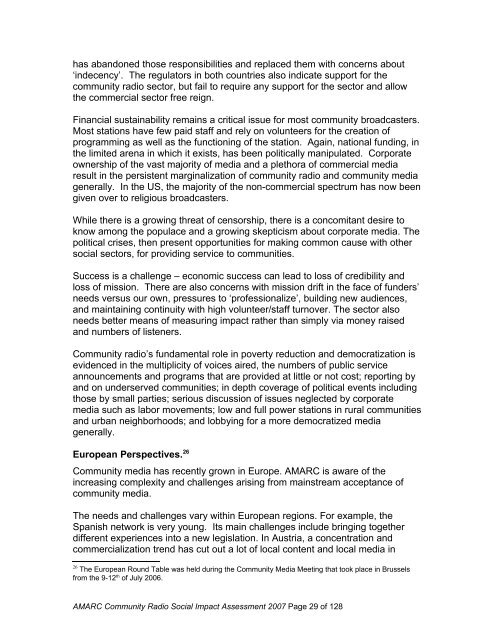Removing Barriers, Increasing Effectiveness - amarc
Removing Barriers, Increasing Effectiveness - amarc
Removing Barriers, Increasing Effectiveness - amarc
Create successful ePaper yourself
Turn your PDF publications into a flip-book with our unique Google optimized e-Paper software.
has abandoned those responsibilities and replaced them with concerns about‘indecency’. The regulators in both countries also indicate support for thecommunity radio sector, but fail to require any support for the sector and allowthe commercial sector free reign.Financial sustainability remains a critical issue for most community broadcasters.Most stations have few paid staff and rely on volunteers for the creation ofprogramming as well as the functioning of the station. Again, national funding, inthe limited arena in which it exists, has been politically manipulated. Corporateownership of the vast majority of media and a plethora of commercial mediaresult in the persistent marginalization of community radio and community mediagenerally. In the US, the majority of the non-commercial spectrum has now beengiven over to religious broadcasters.While there is a growing threat of censorship, there is a concomitant desire toknow among the populace and a growing skepticism about corporate media. Thepolitical crises, then present opportunities for making common cause with othersocial sectors, for providing service to communities.Success is a challenge – economic success can lead to loss of credibility andloss of mission. There are also concerns with mission drift in the face of funders’needs versus our own, pressures to ‘professionalize’, building new audiences,and maintaining continuity with high volunteer/staff turnover. The sector alsoneeds better means of measuring impact rather than simply via money raisedand numbers of listeners.Community radio’s fundamental role in poverty reduction and democratization isevidenced in the multiplicity of voices aired, the numbers of public serviceannouncements and programs that are provided at little or not cost; reporting byand on underserved communities; in depth coverage of political events includingthose by small parties; serious discussion of issues neglected by corporatemedia such as labor movements; low and full power stations in rural communitiesand urban neighborhoods; and lobbying for a more democratized mediagenerally.European Perspectives. 26Community media has recently grown in Europe. AMARC is aware of theincreasing complexity and challenges arising from mainstream acceptance ofcommunity media.The needs and challenges vary within European regions. For example, theSpanish network is very young. Its main challenges include bringing togetherdifferent experiences into a new legislation. In Austria, a concentration andcommercialization trend has cut out a lot of local content and local media in26The European Round Table was held during the Community Media Meeting that took place in Brusselsfrom the 9-12 th of July 2006.AMARC Community Radio Social Impact Assessment 2007 Page 29 of 128
















